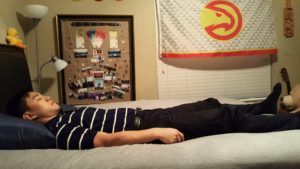Posture and Pain
Posture and Pain
What is “good posture?”
Back and neck pain has become nearly commonplace among office workers today, and the cause is usually attributed to poor posture. Many people resort to a slouching posture (Figure 1) at work because it requires minimal back muscle activation, but most agree that this posture places increased stress on the ligaments and intervertebral discs of the spine. However, the definition of proper sitting posture has been debated. Conventional wisdom posits that sitting fully erect, straightening out every inch of the spine, is proper posture (Figure 2), but in fact, this posture may also result in pain because sitting like this all day can be too demanding for the muscles supporting the spine. The key is finding a balance between the two. Refer to Figure 3 and 4 for ideal sitting postures.
Figure 1: Slouched Sitting Figure 2: Straight Sitting


Faults: Faults:
- Forward, internally rotated shoulders 1. Lack of back support
-> pain between the shoulder blades -> increased stress on back
2. Excessive thoracic curve muscles
-> increased stress on 2. Lack of forearm support
spinal ligaments, discs -> increased stress on
3. Forward head/neck neck/shoulder muscles
-> overworked posterior neck muscles 3. Low workstation
-> tension headaches (head looking down)
-> increased stress on neck
muscles
Figure 3: Ideal Sitting* Figure 4: Modified Sitting


Strengths: Strengths:
1. Back firmly supported, decreasing stress on 1. Back firmly supported, decreasing
spine. stress on spine
2. Natural spinal curvature 2. Stretch and sit at the same time!
3. Head aligned with trunk
*This is a laptop workstation. In the case Prolonged sitting can lead to tight hip
pictured, the keyboard should be elbow level, flexors (front of the hip) and weak
and the eyes are looking downward with a glutes (back of the hip), altering pelvic
slight chin tuck to avoid straining the neck. positioning and creating a potential
If working with a keyboard and monitor, then recipe for back pain. Try this modified
monitor -> eye level position to combat muscular
keyboard -> elbow level imbalances.
Sedentary Kills
“Sitting is the New Smoking.” Headlines like this in recent years tell only half of the story. Sitting is not inherently harmful – chronic sitting is. Research has linked chronic sitting to increased risks of diabetes, heart disease, and death. In other words, it is the sedentary lifestyle that kills. Correcting sitting posture using the abovementioned tips will be a small and easy step to improving quality of life at work, but the ultimate key to feeling better is incorporating more MOVEMENT into the day. In order for joints to stay nourished and lubricated, they need to MOVE. The human body is not designed to stay in prolonged static positions all day. This is why changing positions, standing up, or taking a walk or stretch feels good. Motion is lotion.
The Best Posture is the Next Posture
Here are 5 tips to incorporate more movement into the daily routine.
1) Try a Standing Desk
– Prolonged standing is a better alternative than prolonged sitting
– Facilitates movement (one is more likely to move or take a walk if already standing)
2) Take Breaks
– At LEAST one 5-10 minute break from sitting every hour
– Can be anything from stairs, walking, standing up, or even simply changing sitting posture
3) Take the Stairs
– #1 simple exercise during the work day
– Stimulates the musculoskeletal and cardiovascular systems, combatting physical and mental fatigue
– Suggestion: If the office is on the 10th floor, take the elevator to the 9th, and walk one flight up for a better start to the morning.
4) Drink Water
– Kill two birds with one stone with this “work hack.”
o Hydration is important for physical and mental health
o Having to use the restroom will force one to get up and take a walk
5) Accountability
– Find a coworker with back pain (sadly, not too unlikely)
– Take a walk together at the top of every hour
– Remind each other to MOVE
Sleeping Posture
The principles of posture are different when at rest. At night, the body is not subjected to the compressive forces of gravity in the same way as during the day. Instead, it’s about finding optimal spinal alignment, which will be the least physically demanding position. Waking up with back/neck pain is likely indicative of poor spinal alignment during the night. Physical Therapists recommend either side-sleeping or back-sleeping. Refer below for tips and corrections on how to optimize alignment, decrease pain, and have a better start to the day.
Figure 5: Poor Alignment (Side) Figure 6: Good Alignment (Side)


Faults: Strengths:
1. Bulky head pillow 1. Appropriately sized head pillow
-> strain on neck -> snugly supports head/neck
2. Knees/ankles unsupported 2. Pillow between knees AND ankles
-> strain on hips, low back -> reduces hip/low-back strain
3. Top arm unsupported 3. Pillow under top arm
-> strain on shoulder -> reduces shoulder strain
Figure 7: Poor Alignment (Back) Figure 8: Good Alignment (Back)


Faults: Strengths:
1. Bulky head pillow 1. Appropriately sized head pillow
-> strain on neck, upper-back -> supports head/neck
-> promotes “forward-head -> maintains spinal alignment
posture” 2. Pillow under knees
-> reduces strain on low-back
Consult a Physical Therapist
If you are having trouble managing your neck/back pain on your own, we strongly recommend consulting a skilled Physical Therapist to conduct a formal orthopedic evaluation and ergonomic assessment in order to help find the underlying root of your pain. A Physical Therapist will help you best interpret, understand, and fight the pain, so that you can be on your way to peak health, pain-free function, and improved quality of life throughout the day and night!